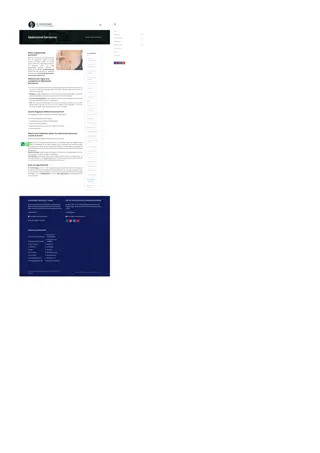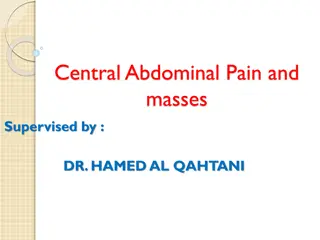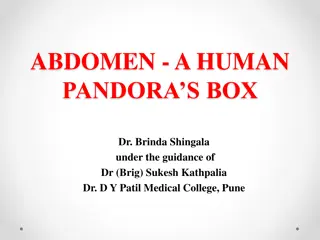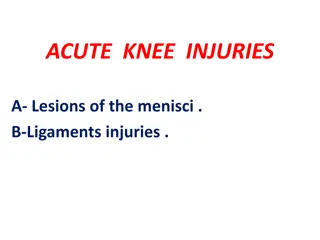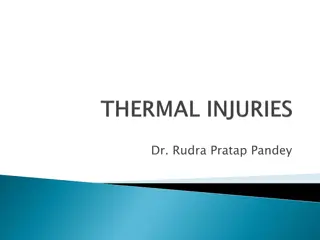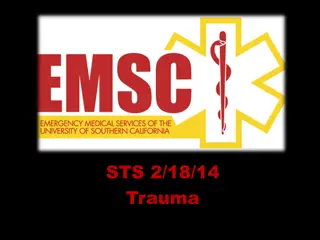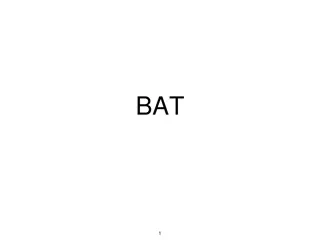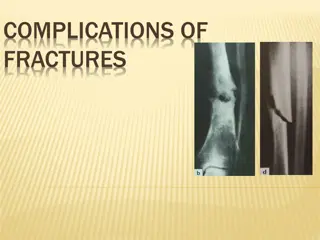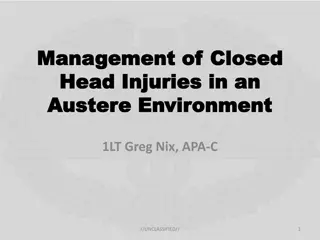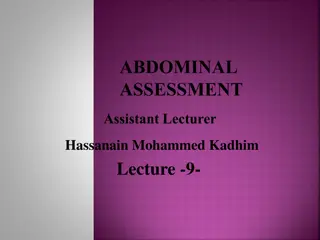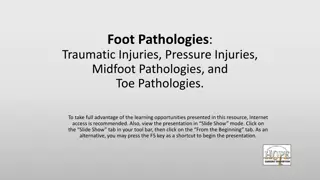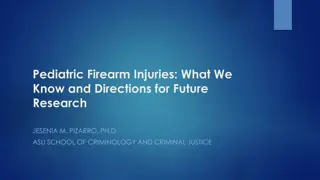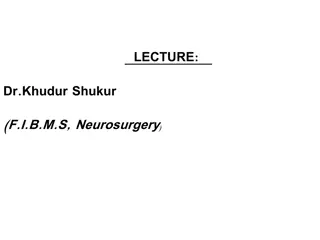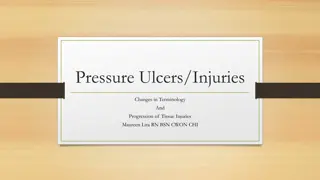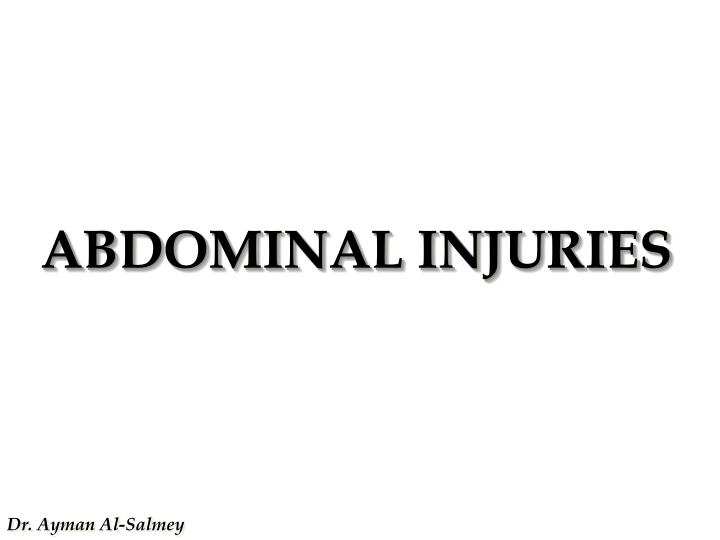
Abdominal Injuries: Causes, Symptoms, and Treatment by Dr. Ayman Al-Salmey
Learn about abdominal injuries, including closed and open injuries, clinical features, diagnosis methods, and treatment options such as exploratory laparotomy. Understand the signs of internal hemorrhage and peritonitis that may follow abdominal trauma. Expert insights provided by Dr. Ayman Al-Salmey.
Uploaded on | 1 Views
Download Presentation

Please find below an Image/Link to download the presentation.
The content on the website is provided AS IS for your information and personal use only. It may not be sold, licensed, or shared on other websites without obtaining consent from the author. If you encounter any issues during the download, it is possible that the publisher has removed the file from their server.
You are allowed to download the files provided on this website for personal or commercial use, subject to the condition that they are used lawfully. All files are the property of their respective owners.
The content on the website is provided AS IS for your information and personal use only. It may not be sold, licensed, or shared on other websites without obtaining consent from the author.
E N D
Presentation Transcript
ABDOMINAL INJURIES Dr. Ayman Al-Salmey
Etiology 1. Closed injuries: Contusions and crush injuries of the abdomen by blows, kicks, falls or run-over accidents often damage the intra- peritoneal viscera without rupturing the muscles of the abdominal wall. 2. Open injuries: Damage to the abdominal viscera may be produced not only by stab, gunshot or impalement injuries to the abdomen, but also by similar injuries to the chest, loin, buttock or perineum. Dr. Ayman Al-Salmey
Clinical features Shock and signs of external trauma to the abdominal wall are often present, but their absence soon after injury does not rule out the possibility of intra- peritoneal damage which will soon manifest itself in one of 2 ways: Dr. Ayman Al-Salmey
1.Internal hemorrhage May arise from injury to the solid viscera, mesenteries or main blood vessels It is characterized by progressive pallor, tachycardia and hypotension with thirst, air hunger and subnormal temperature Locally, there may be tenderness and slight rigidity over the injured organ, and shifting dullness may be elicited Dr. Ayman Al-Salmey
2. Peritonitis Follows rupture of a hollow viscus It manifests itself by pain, tenderness, rigidity, fever and tachycardia. In late cases, there is: (a)Obliteration of liver dullness due to the escape of gas (b)Shifting dullness in the flanks due to the presence of peritoneal exudate (c)Dead silence on auscultation due to paralysis of the gut Dr. Ayman Al-Salmey
Diagnosis 1. Observation:Every patient with a history of abdominal injury should be kept under close observation for at least 24 hours 2. X-ray examination:may reveal gas under the diaphragm, fractures of the ribs, spine or pelvis, and the presence and site of the missile in gunshot wounds 3. Exploratory laparotomy:is indicated whenever suspicious signs are present, and should never be delayed until frank signs appear. As Wallace stated: it is safer to look and see than to wait and see Dr. Ayman Al-Salmey
Treatment Is by urgent exploratory laparotomy after adequate preparation by morphia, transfusion, suction and antibiotics Incision: The abdomen is usually opened through a right paraumbilical paramedian incision On opening the abdomen, any escaping gas, turbid fluid or fecal matter indicates injury to the hollow viscera while a large effusion of blood suggests damage to the solid viscera, omentum or mesentery However, a clean peritoneal cavity does not exclude injury to the bowel since small perforations are readily sealed by prolapsed mucous membrane Dr. Ayman Al-Salmey
Exploration: 1. The solid viscera and mesentery are examined first so that any source of bleeding can be located and dealt with 2. The small intestine is systematically examined throughout its entire length, commencing usually at the cecum. If a perforation is discovered, the affected loop is held in a non-crushing clamp and retained at the surface until the rest of the gut is examined since the discovery of further injuries may influence the treatment to be adopted 3. The stomach and duodenum are inspected and palpated 4. The transverse colon is brought out for examination, and by suitable retraction the other parts of the colon are examined in turn Dr. Ayman Al-Salmey
Procedure: The injured viscera are dealt with as follows: 1. Ruptured spleenis best treated by splenectomy! 2. Liver:The tear is repaired with deeply placed mattress sutures of thick catgut supported by a patch of falciform ligament or rectus sheath so that they do not cut out. If the tear is inaccessible, the abdominal incision is extended into the chest along the right eighth intercostal space to allow proper exposure and debridement 3. Mesentery:Small or radial tears are treated by simple suture, but large or transverse tears interfering with the blood supply of the related segment of bowel are treated by resection-anastomosis Dr. Ayman Al-Salmey
4. Small intestines:Small perforations can be closed by a single purse-string suture, but large wounds are repaired transversely by 2 layers of silk to avoid narrowing of the lumen. Resection-anastomosis is indicated for multiple injuries confined to one segment, for extensive laceration and bruising, and for infarction of the gut due to laceration of the mesentery 5. Colon:Perforations are best treated by exteriorization, the affected loop being mobilized and brought to the surface as in the Paul-Mikulicz's operation for carcinoma 6. Stomach and duodenum:The tear is repaired transversely in two layers to avoid narrowing of the lumen Dr. Ayman Al-Salmey
7. Pancreas: The tear is repaired accurately by silk sutures, and the lesser sac should always be drained through the flank 8. Gall-bladder and bile ducts: Injuries of the gall-bladder are treated by cholecystectomy. A torn common bile duct may be repaired by suture over a T-tube, or by anastomosis to the jejunum 9. Urinary bladder:The tear is repaired in two layers, and an indwelling catheter is inserted for several days to keep the bladder empty Closure:All free fluid in the peritoneal cavity is removed by suction and mopping with abdominal packs. The peritoneal cavity should always be drained by a strip of corrugated rubber inserted at the site of the lesion and brought out through the flank. If frank peritonitis is present, a drain is inserted into the rectovesical pouch through a suprapubic stab Dr. Ayman Al-Salmey



